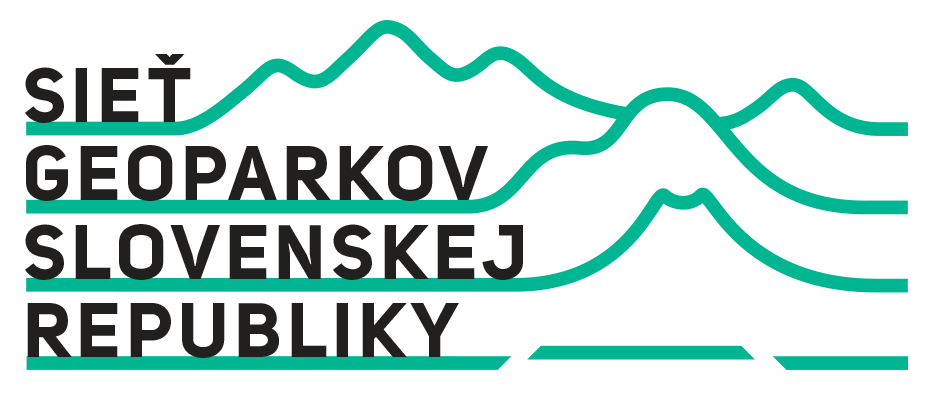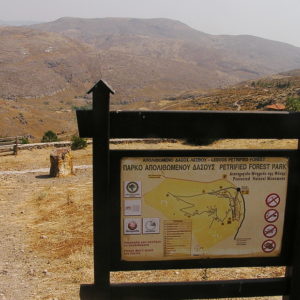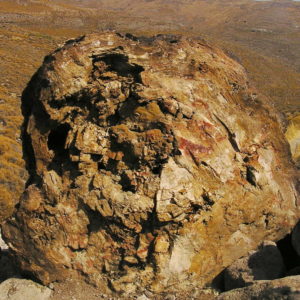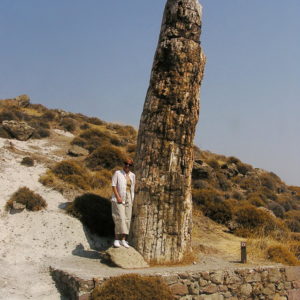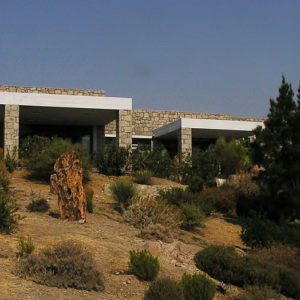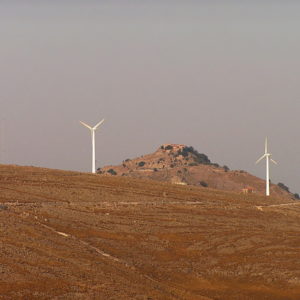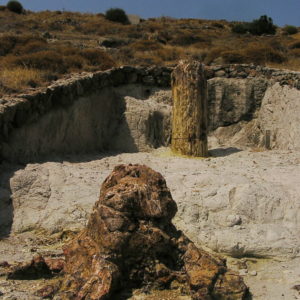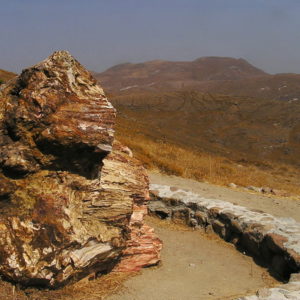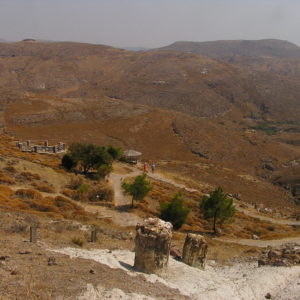How to become a successful geopark
During my summer holiday in 2008, I had the possibility to visit one of the oldest geoparks in Europe – the Petrified Forest on the Greek island Lesbos.
The island Lesbos situated in the northeast part of the Aegean sea is one of the largest Greek islands. In its western part, we can find unique traces after the volcanic activity that took place here 20 million years ago. During this period, several volcanoes originated in the middle of the island. The volcanic activity emitted a huge amount of lava, ash and any other substances that have covered a huge territory. Subsequent heavy rain saturated with ash created huge mud streams of pyroclastic materials moving from east towards west with a high speed and absorbing trees of a dense subtropical forest. The pyroclastic materials have covered vegetation in a hermetic way, whereby they have prevented the access of the air, and the subsequent intensive hydrothermal circulation of liquids rich in silicon caused their perfect petrifaction. Thus the so-called Petrified Forest originated in which a huge quantity of undamaged full-grown trunks of trees have been uncovered until now, also with their root systems, proving that these trees ”petrified“ in their original standing position. In addition to trees, fruit, leaves and seeds have also been preserved here perfectly.
Thanks to its huge ecological, geological and paleontological value, this region was declared to be the protected natural monument in 1984. In 1994, the Natural History Museum of the Lesbos Petrified Forest was opened in the small town of Sigri. Greece was a co-founding member of the European Geoparks Network (EGN) and in 2004 this geopark was included in the list of the Global Geoparks Network (GGN) of UNESCO.
The overall philosophy of the geopark was built on the idea to present events that took place in one geological epoch – Miocene (the Tertiary, approximately 24 million years ago), even if some other geological phenomena or events can also be found on the island. The geopark consists of the following localities:
Natural History Museum of the Lesbos Petrified Forest;
natural parks in the wild: Petrified Forest, Plaka, Sigri, Skamniouda, and the small island of Nisiopi.
Marked tourist pathways have been built among the individual parks.
As the first step for understanding phenomena of the geopark it is recommended to visit the museum. The museum occupies the area of 1,597 m2 and is composed of the permanent exposition, spaces for occasional exhibitions, libraries, laboratories, audio-visual multi-purpose spaces, cafes, a small shop with souvenirs, and a special accommodation facility for scientists and students.
The first exhibition room ”Paleobotany – Petrified Forest“ represents the evolution of life of plants on the Earth from the appearance of the first one-cell organisms 3.5 billion years ago up to blooming plants and the creation of the petrified forest. The flora of petrified forest is represented here by fossils of more than 40 various woody plants, such as palms, cinnamon trees, rhododendron, citrus trees, beech, oak, walnut, alder, hornbeam, yew, pine tree, cypress tree, or impressive sequoias. Petrified tree trunks, branches, small branches, impressive petrified leaves, imprints of leaves, fruit and roots are exhibited in front of large-scale illustrated pictures of the individual plant species. In this hall, you can also find the first evidence of the existence of animals that lived in a petrified forest – among other things a jaw bone of extinct Tertiary proboscidean, a predecessor of elephant.
In the second hall called “Development of the Aegean sea“ various geological phenomena and processes related to the creation of the petrified forest and the general history of the coast of the Aegean sea for a period of the preceding 20 million years are presented. The main themes include the movement of lithospherical mantles in the region, the department of African lithosphere and the development of volcanic activities in the region. Models of volcanic rocks and stratigraphy of volcanic products, paleogeographical reconstruction of the development of the region from Tithios at the sea up to Aegis on the continent and the creation of the Greek island Archipelago are exhibited here. The exhibition also includes seismographs, permanently recording the seismic activity in the region.
In the museum, there are laboratories completely equipped for studying and research, so the museum is also an important centre of the complex geological research in Greece. In the museum premises, various occasional exhibitions of photographs and other artworks are organized.
The museum is a host of international conferences and symposia, cultural events, seminars and film performances. It has developed various educational programmes attracting pupils and students not only from Lesbos, but also from whole Greece and abroad, mainly outside the summer season.
Under research programmes, the museum cooperates with some other organizations – museums, universities, and research workplaces in both Greece and abroad.
A museum small coffee bar is also worth paying attention – in addition to excellent Greek coffee frappe, a visitor can choose here, apart from souvenirs and artworks, from a wide range of regional products – typical Greek sweets, olive oil, products made of honey and olives, herbal teas, ouzo, or retsina. The museum administers the network of local entrepreneurs who cooperate with the geopark in various spheres – not only in the production of souvenirs and typical local products, but also in the sphere of accommodation, meals. Based on these activities, tourism has increased considerably in the western part of Lesbos and new jobs interconnected to geo tourism were created.
The unique experience is visiting on the spot – in the Petrified Forest Park. If you decide to visit it in the summer, you have to be prepared for desert conditions – hot weather, dry and dusty wind and temperatures high above 40 oC. In the area of 28.6 ha, a huge amount of petrified trees are made accessible that created an undamaged forest ecosystem in the past. Nowhere in the world there are so many trunks of trees discovered, particularly not in the standing position. Every visitor will be captivated by an unusual composition of colourful combinations, naturally decorating petrified trees, or genuineness of prehistoric trunks, where every detail has been preserved. Standing and laying trees are scattered all over the surroundings, while the biggest laying tree reaches the length of 22 m and the highest standing trunk of sequoia is, with its 7 metres, also the highest one in whole Europe.
In what one can see the secret of success of the geopark that is situated on a relatively remote island in the Aegean sea?
- functional management – the basis of the management is the geopark functioning under the “roof” of the museum, interconnecting activities and interests of the museum with the geopark activities;
- elaborated marketing – constant presentation of the geopark at various levels both at home and abroad – a number of articles, various promoting materials, information marking all over the whole island Lesbos. The agreement between the geopark and the Museum of Industrial Olive Oil Production in the small village of Agia Paraskevi situated in a different part of the island serves as interesting inspiration – when you visit the geopark, you will get brochures and information on the Olive Oil Museum and, on the contrary, in the Olive Oil Museum you will be bombarded with information on the geopark;
- networking of local entrepreneurs and sole traders, services and products of whom can be used for the geopark – accommodation services and meals, manufacturing products from local raw materials;
- sale of products from local producers in the museum premises;
- active participation in the European and Global Geoparks Network. The geopark manager, Prof. Nickolas Zouros, is also – in addition to managing the museum and geopark – the Professor at the Aegean University in Mytilini and the Deputy Chairman of the European Geoparks Network;
- implementation and participation in many international and cross-border projects and programmes (INTERREG IIIc, LEADER+);
- rewritten programme of the geopark activities in the summer touristic season and outside the season when they are mainly focused on educational programmes for pupils and students coming here from whole Greece, and various workshops and seminars on the subject of geotourism, geo preservation or geo management intended for employees of the European geoparks management. In this period, doors of the geopark are also open for studying stays of scientific employees.
At present, the Slovak geoparks are already gradually preparing for the candidature for the European Geoparks Network. Visiting the geopark described above would be very important inspiration and gaining useful experience for them.
Photo gallery from the geopark
